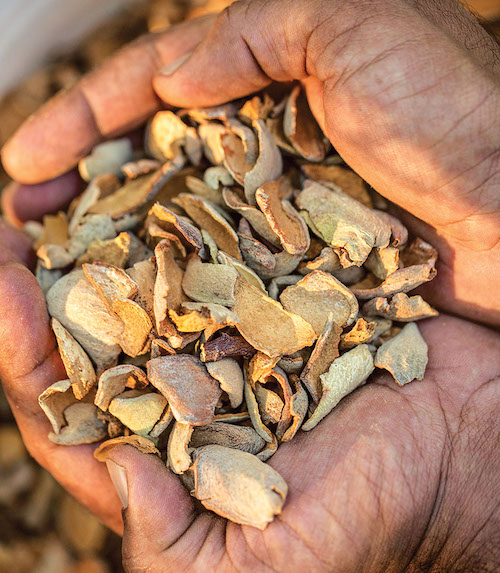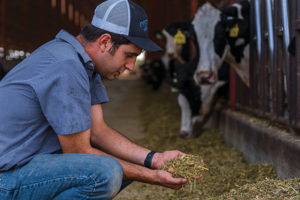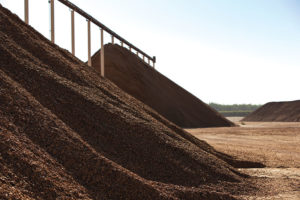
Mar/Apr 2022
Zero waste in almonds
In today’s complex and ever changing times, innovation is not just important and profitable, it’s imperative. With resources taxed, such as water in California, it’s a boon when industries decide to take the initiative and commit to creating zero waste.
The 2025 Zero Waste Goal is an initiative that the California Almond Board is pursuing, which focuses on whole orchard recycling, livestock feed and other use opportunities.
From cattle feed to human consumption
Hull uses are gaining in popularity as research continues to look at additional use options. The hull of the almond is a good source of sugar, fiber, phytochemicals and antioxidants, which not only spurred the use in dairy feed, but is propelling research for hull use in human food products.

The dairy industry is the biggest consumer of almond hulls, nearly taking all of the supply and using it as feed without any negative impact on the performance of the animal. This displaces the need for dairy farmers to buy or grow alfalfa and other feed grains.
Hulls are also showing promise as poultry feed, as research shows healthy growth for both broiler chickens and egg layers. Hulls used in feed may help reduce salmonella, typically associated with uncooked chicken meat, and improve the quality of the egg yolk because of the hull’s composition. Further research is underway to determine if these promising benefits will last over the lifetime of either type of chicken.
The University of Georgia already has related research going back a few years, and the hope for California is that not only will hulls prove to be a useful feed item for poultry, but using them as such will reduce the carbon emissions and costs associated with shipping feed.
“Hulls are a bulky product, and it’s not cost effective to ship them all over the country,” said Josette Lewis, chief scientific officer for the Almond Board of California. “There are several chicken farms in California, and countless egg farms in the region, leading to a lot of opportunities to reuse these hulls.”
Though almond hulls are not currently cleared by the FDA for human consumption, increased research in this area may soon change that. Hulls have been tested for minimum residue levels from any applications, and while they are testing below minimum levels and will be further cleaned in any secondary processing, hull use in food products is new territory.
“Historically, there are certain cultures that do eat green almonds, which includes the hull. But we want to make sure we’ve got the evidence to the highest standard on its safety,” said Lewis.
In a world where alternative, naturally occurring food products are not only becoming more accepted and sought after, it may be possible for the hull to be used as a food additive, like in nutrition bars where almonds are already used. Thirty years ago, few people, if anyone, knew that dairy cows enjoyed almond hulls, and as tools for achieving zero waste constantly evolve, the industry continues to sustainably make more while using less.
“The goal of the almond industry is not only to have zero waste,” said Lewis, “but to add additional value back into the industry by identifying the most diversified and higher value uses of hulls.”
Torrefaction and ‘carbon black’
Through the process of torrefaction, a form of pyrolysis, where organic matter is heated in a low-oxygen environment, the tree waste can be made into a form of carbon known as ‘carbon black.’ This can be mixed with recycled plastics, improving their strength and heat stability, and other materials, and can then close the loop on the number of new plastics in the environment.
Another form – activated carbon – can be used in water treatment processes, from food processing facilities to municipal water systems and others, which requires large amounts of activated carbon to filter water. Most of the activated carbon comes from internationally imported items, such as coconut husks. Using almond orchards for this process has a two-pronged effect of reduced orchard waste and cost effectiveness.

“The opportunity to use homegrown almond activated carbon would be a great opportunity,” Lewis said. “One that really scales and could add significant value to the almond industry, as well as potentially reduce the carbon footprint of our water treatment facilities.”
There are also companies – such as Yosemite Clean Biofuels, Caribou Biofuels and West Biofuels – that are able to take almond biomass and convert it into second generation biofuels.
From whole orchard recycling, to livestock feed, to potential use in cosmetics, diversification is key to zero waste. Moving forward multiple projects will ultimately steer the industry toward the use that makes the most sense.
“We’re not guaranteed that any of these things will work out or be attractive enough financially for the industries. We’re going to be displacing something else that they currently use,” said Lewis. “We have a portfolio approach … if something were to really take off, over time, that might displace some of the other uses or just diversify them. It’s hard to predict, but we’ll be successful.”
Hitting the 2025 goals
Almond whole orchard recycling is the first major initiative to use all of the byproducts of the orchard and could bring some light to some other organic producers, leading the way to create complete sustainability from orchards.
Walnut growers have started looking into utilization of byproducts, and some fruit producers have invested into ways to utilize pulp, peels and other materials.
There’s also work being done to calculate true water usage, as many products come out of the orchard, not just the kernel. For example, hulls used as feed means a water reduction in the growing of hay for the same purpose.
So how close is the almond industry to reaching its zero waste goal?
“With zero waste, I would say we’re there now. We don’t waste any products,” Lewis said. “We still would like to raise the value – the ‘optimal use’ part – of that goal, and that’s the new journey that we’re on.”
Photos: Almond Board of California







